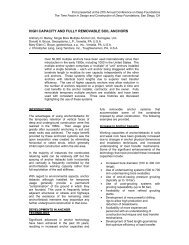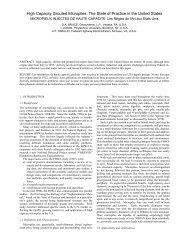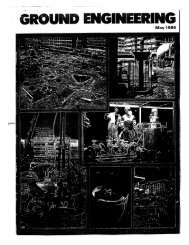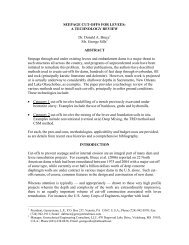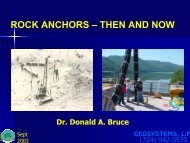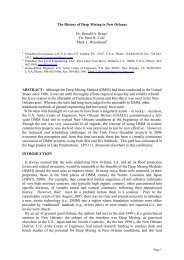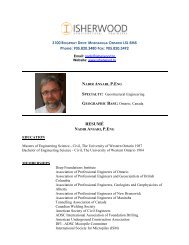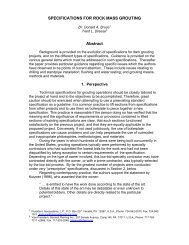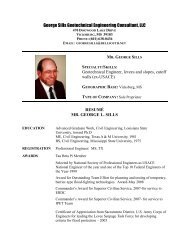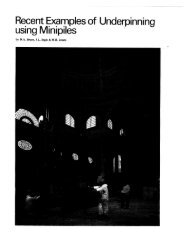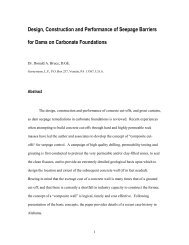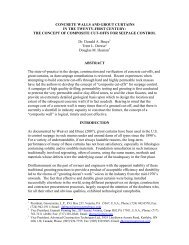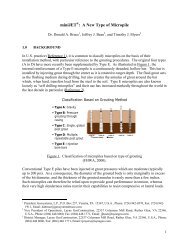1 Dam Remediation by Anchors and Cut-Offs: A ... - Geosystems, LP
1 Dam Remediation by Anchors and Cut-Offs: A ... - Geosystems, LP
1 Dam Remediation by Anchors and Cut-Offs: A ... - Geosystems, LP
You also want an ePaper? Increase the reach of your titles
YUMPU automatically turns print PDFs into web optimized ePapers that Google loves.
Epoxy-coated str<strong>and</strong> (Supplement)<br />
This material <strong>and</strong> its use was first discussed systematically in 1996, although minor<br />
references had been made in 1986. The 2004 document contains a separate<br />
supplement dealing with specifications, materials, design, construction <strong>and</strong> testing,<br />
being a condensed <strong>and</strong> modified version of a document produced <strong>by</strong> the ADSC<br />
Epoxy-Coated Str<strong>and</strong> Task Force in November 2003. The Scope (Section 1) notes<br />
that anchors made from such str<strong>and</strong> “require experience <strong>and</strong> techniques beyond those<br />
for bare str<strong>and</strong> anchors.” The supplement is a condensed version of the “Supplement<br />
for Epoxy-Coated Str<strong>and</strong>” as prepared <strong>by</strong> the ADSC Epoxy-Coated Str<strong>and</strong> Task<br />
Force (November 2003). It supplements the recommendations provided in the<br />
general recommendations with respect to specifications/responsibilities/submittals;<br />
materials; design; construction; <strong>and</strong> stressing <strong>and</strong> testing.<br />
2.2.3 The Issue of Corrosion Protection<br />
1974. Figure 1 illustrates the very simple approach to tendon protection, i.e., cement<br />
grout or nothing. “Permanent” is defined as “generally more than a 3-year service<br />
life.” Sheathing is only discussed as a debonding medium, not a corrosion protection<br />
barrier. For permanent anchors “protective corrosion seals over their entire<br />
length“ are to be provided (but are not defined). For two stage grouted tendons,<br />
sheathing can be omitted, the implication being that cement grout alone would be<br />
acceptable.<br />
1980. The same Figure 1 is reproduced (as it was also in 1986). The term<br />
“permanent” is now reduced to 18 months or more, <strong>and</strong> growing attention is drawn to<br />
the requirements of permanent anchors: sheathing is for debonding “<strong>and</strong>/or to<br />
provide corrosion protection,” as is secondary cement grout. Corrugated protection,<br />
<strong>and</strong> epoxy coating for bars, are discussed.<br />
The type <strong>and</strong> details of corrosion protection are to be based on longevity,<br />
anchor environment, consequences of future <strong>and</strong> in-hole conditions/length of time<br />
before grouting. For the bond length, cement grout is considered “the first level of<br />
corrosion protection,” <strong>and</strong> plastic corrugated sheathing (“for multiple corrosion<br />
protection schemes”) or epoxy are permitted. Such protection is to extend at least 2<br />
feet into the free length. The free length is to have, as a minimum, a sheath with<br />
cement grout or grease infill. A full length outer sheath is regarded as “good<br />
practice.”<br />
1986. The emphasis is placed on first investigating the chemical aggressiveness of<br />
the soil <strong>and</strong> ground water: “Permanent anchors placed in environments where any one<br />
of these tests indicate critical values must be encapsulated over their full length.”<br />
Thus, even up until the next set of Recommendations (1996), it was considered<br />
acceptable to allow anchors for dams to be installed without any protection for the<br />
bond length other than cement grout, depending on the results of laboratory tests on<br />
small samples. Encapsulation was not detailed.<br />
8



